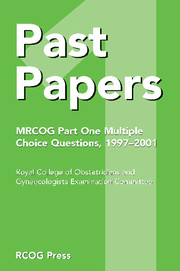Book contents
- Frontmatter
- Contents
- Introduction
- March 1997 – Paper 1
- March 1997 – Paper 2
- September 1997 – Paper 1
- September 1997 – Paper 2
- March 1998 – Paper 1
- March 1998 – Paper 2
- September 1998 – Paper 1
- September 1998 – Paper 2
- March 1999 – Paper 1
- March 1999 – Paper 2
- September 1999 – Paper 1
- September 1999 – Paper 2
- March 2000 – Paper 1
- March 2000 – Paper 2
- September 2000 – Paper 1
- September 2000 – Paper 2
- March 2001 – Paper 1
- March 2001 – Paper 2
- September 2001 – Paper 1
- September 2001 – Paper 2
- Index
March 1998 – Paper 1
Published online by Cambridge University Press: 05 July 2014
- Frontmatter
- Contents
- Introduction
- March 1997 – Paper 1
- March 1997 – Paper 2
- September 1997 – Paper 1
- September 1997 – Paper 2
- March 1998 – Paper 1
- March 1998 – Paper 2
- September 1998 – Paper 1
- September 1998 – Paper 2
- March 1999 – Paper 1
- March 1999 – Paper 2
- September 1999 – Paper 1
- September 1999 – Paper 2
- March 2000 – Paper 1
- March 2000 – Paper 2
- September 2000 – Paper 1
- September 2000 – Paper 2
- March 2001 – Paper 1
- March 2001 – Paper 2
- September 2001 – Paper 1
- September 2001 – Paper 2
- Index
Summary
1. In the abdominal wall
A. the rectus abdominis muscle is attached to the crest of the pubis.
B. the posterior border of the external oblique muscle ends in the linea semilunaris.
C. the aponeurosis of the external oblique muscle takes part in the formation of the conjoint tendon.
D. the inferior epigastric artery is a branch of the internal iliac artery.
E. the conjoint tendon blends medially with the anterior layer of the rectus sheath.
2. The pelvic splanchnic nerves
A. contain parasympathetic fibres.
B. unite with branches of the sympathetic pelvic plexus.
C. are pre-ganglionic fibres.
D. supply the bladder sphincter with motor fibres.
E. supply the uterus with vasodilator fibres.
3. The vulva and perineum are supplied by the following nerves:
A. sciatic.
B. posterior cutaneous of thigh.
C. inferior rectal.
D. ilioinguinal.
E. obturator.
4. The adult spinal cord
A. commences at the foramen rotundum.
B. ends at the level of the upper lumbar vertebrae.
C. lies posterior to the spinal laminae.
D. is enclosed within a single layer of dura mater.
E. has a thoracic parasympathetic outflow.
5. The vaginal epithelium at puberty
A. thickens.
B. develops goblet cells.
C. forms cilia.
D. stores glycogen.
E. keratinises.
6. The urinary bladder
A. has an epithelium derived from endoderm.
B. has a venous plexus draining to the external iliac veins.
C. is situated in the abdomen of the young child.
D. is separated from the symphysis pubis by a fold of peritoneum.
E. has a blood supply from the inferior epigastric artery.
- Type
- Chapter
- Information
- Past Papers MRCOG Part One Multiple Choice Questions1997–2001, pp. 41 - 50Publisher: Cambridge University PressPrint publication year: 2004



